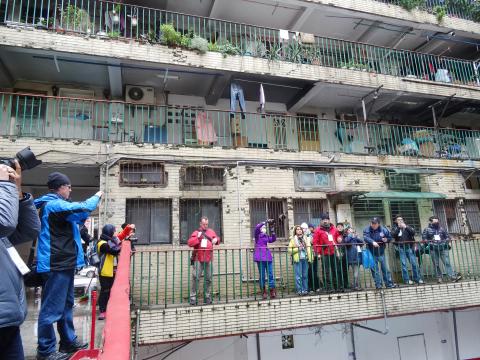The last time TC Lin (林道明) tried to organize a photography walk around Zhongzheng District’s (中正) dilapidated Nanjichang (南機場) neighborhood, it snowed in Taipei.
A street and documentary photography instructor at Zhongzheng Community College, Lin is hoping for better weather tomorrow as he attempts to gather photographers — amateurs and professionals alike — to capture everyday life in this 52-year-old community of about 2,000 households before it disappears to the city’s urban renewal plan.
Once a “model community,” the neighborhood has deteriorated over the years and is now largely occupied by elderly living alone or low-income families. The renewal project has been in talks for many years, but progress has stalled due to a number of problems including resident eligibility and the debate on whether to keep the community’s elementary school.

Photo courtesy of TC Lin
“I talked to the borough warden and he wants to leave a recording of the people, objects and life in the community,” Lin says. “He invited photography students before, but they only took pretty pictures such as flowers and sunsets.”
That’s where Lin’s expertise comes in. He named the event “international photo walk” because he wants to encourage foreign photographers to join in.
“I think it would be interesting to include their point of view in this documentation of the community,” he says. “Their angle and style are often different from Taiwanese.”
The borough warden will give a presentation on the community and take the photographers on a tour — including places that are not usually accessible to the public. Lin says he will provide translation and answer questions for those who don’t understand Chinese, though he hopes that there are more bilingual people on the scene to assist him.
Participants don’t need to be too self-conscious about intruding, as the borough warden has notified residents of the photography tour.
However, Lin says the number one key to documentary photography is respecting the subjects.
“You want to record the people and place because you like them and you respect them,” he says. “What mentality you use to photograph your subject is important because he or she will feel it too.”
Lin hopes to turn the results into an exhibition, set tentatively for late March or early April. He also wants to host a forum with exchanges between local and foreign photographers.

Exceptions to the rule are sometimes revealing. For a brief few years, there was an emerging ideological split between the Democratic Progressive Party (DPP) and Chinese Nationalist Party (KMT) that appeared to be pushing the DPP in a direction that would be considered more liberal, and the KMT more conservative. In the previous column, “The KMT-DPP’s bureaucrat-led developmental state” (Dec. 11, page 12), we examined how Taiwan’s democratic system developed, and how both the two main parties largely accepted a similar consensus on how Taiwan should be run domestically and did not split along the left-right lines more familiar in

As I finally slid into the warm embrace of the hot, clifftop pool, it was a serene moment of reflection. The sound of the river reflected off the cave walls, the white of our camping lights reflected off the dark, shimmering surface of the water, and I reflected on how fortunate I was to be here. After all, the beautiful walk through narrow canyons that had brought us here had been inaccessible for five years — and will be again soon. The day had started at the Huisun Forest Area (惠蓀林場), at the end of Nantou County Route 80, north and east

Specialty sandwiches loaded with the contents of an entire charcuterie board, overflowing with sauces, creams and all manner of creative add-ons, is perhaps one of the biggest global food trends of this year. From London to New York, lines form down the block for mortadella, burrata, pistachio and more stuffed between slices of fresh sourdough, rye or focaccia. To try the trend in Taipei, Munchies Mafia is for sure the spot — could this be the best sandwich in town? Carlos from Spain and Sergio from Mexico opened this spot just seven months ago. The two met working in the

This month the government ordered a one-year block of Xiaohongshu (小紅書) or Rednote, a Chinese social media platform with more than 3 million users in Taiwan. The government pointed to widespread fraud activity on the platform, along with cybersecurity failures. Officials said that they had reached out to the company and asked it to change. However, they received no response. The pro-China parties, the Chinese Nationalist Party (KMT) and Taiwan People’s Party (TPP), immediately swung into action, denouncing the ban as an attack on free speech. This “free speech” claim was then echoed by the People’s Republic of China (PRC),